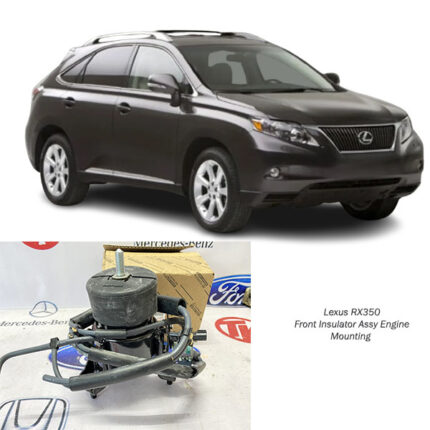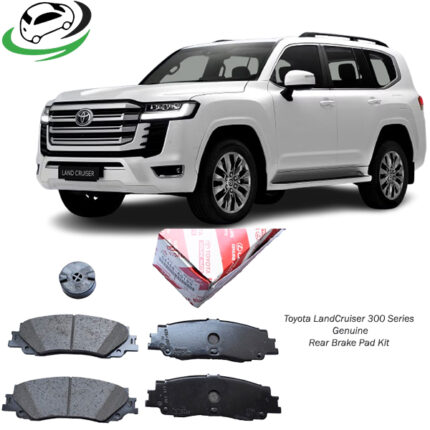-7%Hot
Get Toyota Land Cruiser 300 Series Genuine Rear Brake Pads 04466-60190
The Toyota Land Cruiser 300 Series is a symbol of rugged luxury, known for its off-road capabilities and refined driving experience. One of the most important components of any vehicle, especially a large SUV like the Land Cruiser, is its braking system. The rear brake pads play a vital role in ensuring safety, control, and reliability, particularly when driving on challenging terrains or carrying heavy loads. This guide explores the function, benefits, materials, maintenance, and replacement process of genuine rear brake pads for the Toyota Land Cruiser 300 Series.
What Are Rear Brake Pads?
Brake pads are friction materials that press against the brake rotors (discs) to create the necessary friction for slowing down or stopping the vehicle. In a disc brake system, brake pads work with calipers, rotors, and hydraulic fluid to effectively bring the vehicle to a stop. Rear brake pads, in particular, provide a significant portion of the braking force, although they generally do not wear as quickly as front brake pads, due to the weight distribution and braking dynamics of most vehicles.
For a vehicle as robust and performance-oriented as the Toyota Land Cruiser 300 Series, using genuine rear brake pads is crucial for maintaining the vehicle’s braking efficiency, ensuring the correct fit, and optimizing longevity. Toyota’s genuine brake pads are specifically designed to match the characteristics of the Land Cruiser, providing dependable stopping power in a variety of driving conditions.
Function of Rear Brake Pads
The rear brake pads have a few key functions:
- Slowing and Stopping: Rear brake pads press against the brake rotors when you apply the brake pedal, generating friction to slow the vehicle down. The harder you press the brake pedal, the more pressure is applied, bringing the vehicle to a stop.
- Heat Dissipation: As the brake pads generate friction, heat is produced. The design of the brake pad material ensures that heat is dissipated effectively to prevent overheating, brake fade, or component damage.
- Even Braking: Rear brake pads work in conjunction with front brake pads to distribute braking forces evenly across all four wheels. This balance ensures vehicle stability and prevents skidding or oversteering, especially during emergency braking.
- Load Distribution: On vehicles like the Land Cruiser, rear brakes are essential for maintaining stability when carrying heavy loads, towing, or navigating steep inclines. Rear brake pads assist in handling the additional forces acting on the rear axle during braking.
Materials Used in Genuine Rear Brake Pads
Toyota’s genuine brake pads are made from a range of materials, each offering distinct advantages in terms of performance, longevity, and heat resistance. The choice of material for brake pads affects their durability, noise levels, and braking power. Common materials used in Toyota Land Cruiser 300 Series genuine rear brake pads include:
- Semi-Metallic Brake Pads: These are a mix of metals (such as steel, copper, or iron) and other fillers, bound together with resin. Semi-metallic pads are known for their excellent heat resistance and durability, making them suitable for heavy-duty applications, such as off-roading or towing. However, they may produce more noise and brake dust compared to other types.
- Ceramic Brake Pads: Ceramic brake pads are made from ceramic fibers, bonding agents, and other materials like fine copper fibers. They offer quieter operation and produce less brake dust than semi-metallic pads. Ceramic pads are also known for their longevity and consistent performance under a range of temperatures, making them ideal for high-performance vehicles like the Land Cruiser.
- Organic (Non-Asbestos Organic, NAO) Brake Pads: These are made from organic materials like rubber, glass, and resins. While they are quieter and produce less dust, they tend to wear out faster and may not offer the same level of performance as semi-metallic or ceramic pads, especially in demanding driving conditions.
Toyota genuine rear brake pads for the Land Cruiser 300 Series typically feature ceramic or semi-metallic compositions, offering a balance between longevity, noise reduction, and braking performance.
Benefits of Genuine Rear Brake Pads
Choosing genuine Toyota brake pads for the Land Cruiser 300 Series offers several benefits over aftermarket alternatives, including:
- Optimal Performance: Genuine Toyota brake pads are engineered specifically for the Land Cruiser 300 Series, ensuring a precise fit and reliable braking performance. They are designed to handle the vehicle’s weight, power, and off-road capabilities, providing maximum stopping power in all conditions.
- Enhanced Safety: Safety is the top priority when it comes to brake components. Toyota’s genuine rear brake pads are rigorously tested to meet strict safety standards, ensuring that they deliver consistent braking performance, even in extreme conditions such as wet, icy, or uneven terrain.
- Longer Lifespan: Genuine brake pads are made from high-quality materials that resist wear and heat damage, providing a longer service life compared to cheaper aftermarket options. This longevity helps reduce the frequency of brake pad replacements, saving both time and money in the long run.
- Reduced Noise and Dust: Toyota genuine rear brake pads are designed to minimize brake noise and dust, resulting in a quieter and cleaner driving experience. This is particularly important in luxury SUVs like the Land Cruiser, where noise reduction contributes to overall comfort.
- Warranty Protection: Using genuine Toyota parts helps maintain the vehicle’s warranty. Aftermarket brake pads, while potentially cheaper, may void certain warranty claims if they cause damage to other components or do not perform as expected.
Signs of Worn Rear Brake Pads
Regular maintenance and inspection of your vehicle’s brake pads are essential for ensuring safe operation. Here are some common signs that your Land Cruiser 300 Series rear brake pads may be worn and need replacement:
- Squealing or Squeaking Noise: High-pitched noises when braking are often the first indicator of worn brake pads. Most brake pads have a wear indicator that emits a sound to alert the driver that it’s time for replacement.
- Reduced Braking Performance: If the vehicle takes longer to stop or if the brakes feel less responsive, it could be a sign that the brake pads are worn thin and need to be replaced.
- Grinding Noise: A grinding or scraping sound indicates that the brake pads are completely worn down, and the metal backing plate is making contact with the rotor. This can cause significant damage to the brake rotors and calipers, requiring costly repairs.
- Vibration or Pulsation: If you feel vibrations or pulsations through the brake pedal when applying the brakes, it could be a sign of uneven wear or a warped rotor. This often happens when brake pads are severely worn and unable to dissipate heat properly.
- Visual Inspection: You can also inspect the brake pads visually by looking through the wheel spokes. If the pads appear to be less than 3mm thick, it’s time to replace them.
Maintenance Tips for Rear Brake Pads
To maximize the lifespan and performance of your Land Cruiser 300 Series rear brake pads, regular maintenance is essential. Here are some tips to keep your brakes in optimal condition:
- Regular Inspections: Have your brake pads inspected regularly, especially if you frequently drive in heavy traffic, off-road, or tow heavy loads. Many manufacturers recommend brake pad inspections every 12,000 to 15,000 miles, but this can vary depending on your driving habits.
- Check Brake Fluid: Brake fluid plays a vital role in the operation of your brake system. Ensure that the brake fluid is topped up and replaced according to the manufacturer’s recommendations.
- Avoid Harsh Braking: Aggressive braking increases wear on the brake pads and can cause them to overheat. Whenever possible, apply the brakes smoothly and gradually to prolong the life of the brake pads.
- Rotate Tires: Regular tire rotation helps distribute wear evenly across all four tires and reduces strain on the brakes. It also allows for inspection of the brake pads during tire rotation.
- Replace in Pairs: When replacing brake pads, it’s important to replace both rear pads at the same time to ensure balanced braking performance.
Replacement Process of Rear Brake Pads
Replacing rear brake pads on the Toyota Land Cruiser 300 Series is a straightforward process for a qualified mechanic, but it does require attention to detail to ensure the brakes function properly. The basic steps include:
- Lift the Vehicle: Use a jack to lift the rear end of the vehicle and remove the rear wheels to access the brake calipers.
- Remove the Brake Caliper: Unbolt the brake caliper and slide it off the brake rotor. Be careful not to let the caliper hang by the brake hose; instead, secure it with a caliper hanger or zip ties.
- Remove Old Brake Pads: Slide the old brake pads out of the caliper bracket. If necessary, use a brake pad spreader tool to compress the caliper piston.
- Install New Brake Pads: Insert the new brake pads into the caliper bracket, making sure they are properly seated and aligned.
- Reassemble the Brakes: Reattach the brake caliper, ensuring all bolts are properly torqued to the manufacturer’s specifications.
- Test the Brakes: Once the brake pads are installed, test the brake pedal for proper feel and ensure there are no unusual noises or vibrations when braking.
Conclusion
The Toyota Land Cruiser 300 Series is a vehicle built for performance, luxury, and durability, and its braking system is a key component in maintaining these standards. Genuine rear brake pads are specifically designed to provide optimal performance, safety, and longevity for this heavy-duty SUV. By choosing genuine parts, maintaining regular inspections, and replacing worn brake pads promptly, you can ensure your Land Cruiser remains reliable and safe for all your driving adventures.
Follow us on Facebook for more parts.




